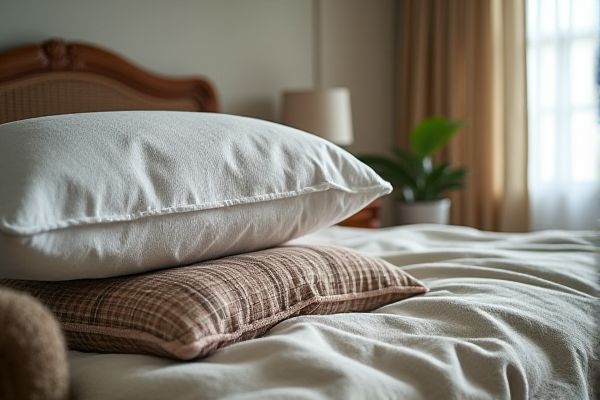
Weather-resistant cushions are designed to withstand elements like UV rays, moisture, and mildew but may not be completely impervious to water, while waterproof cushions provide a higher level of protection by fully preventing water from penetrating the fabric. Understanding the differences between these cushions can help you choose the best option for your outdoor comfort needs--read on to discover which cushion suits your lifestyle.
Table of Comparison
| Feature | Weather-Resistant Cushion | Waterproof Cushion |
|---|---|---|
| Material | Usually made from water-repellent fabrics like polyester or olefin | Constructed with impermeable layers such as vinyl or coated fabrics |
| Water Protection | Resists moisture but may absorb water over time | Completely blocks water penetration |
| Breathability | Allows some air flow to reduce mildew | Minimal breathability, can trap moisture inside |
| Comfort | Soft and comfortable for seating | May feel less breathable and slightly plasticky |
| Durability | Good for moderate outdoor exposure | Highly durable and ideal for heavy outdoor use |
| Maintenance | Requires regular drying and cleaning | Easy to wipe clean, no drying needed |
| Price | Generally more affordable | Usually more expensive due to material |
Introduction to Weather-Resistant and Waterproof Cushions
Weather-resistant cushions are designed with materials that repel moisture and resist fading, mold, and mildew, making them ideal for outdoor use in varied climates. Waterproof cushions, however, provide a complete barrier against water penetration, ensuring your cushion stays dry even in heavy rain or accidental spills. Choosing the right cushion depends on your outdoor environment and how you prioritize durability and protection for your seating.
Key Differences Between Weather-Resistant and Waterproof Cushions
Weather-resistant cushions are designed to withstand light moisture, UV rays, and mildew, providing durability for outdoor use without being completely impervious to water. Waterproof cushions feature a protective coating or membrane that fully blocks water penetration, ensuring they remain dry and mold-free even in heavy rain or wet conditions. Key differences lie in their material construction, with weather-resistant cushions prioritizing breathability and comfort, while waterproof cushions emphasize total moisture barrier for maximum protection.
Materials Used in Weather-Resistant Cushions
Weather-resistant cushions are typically made from materials such as solution-dyed acrylic, olefin, and polyester blends, which resist fading, mildew, and moisture absorption while allowing breathability. These fabrics often have a protective coating that repels water but still permit airflow, preventing mold and mildew growth. Your choice of weather-resistant cushion ensures durability and comfort in outdoor environments without the stiffness commonly found in fully waterproof options.
Materials Used in Waterproof Cushions
Waterproof cushions typically use materials such as vinyl, coated polyester, or polyurethane to create a barrier that prevents water penetration. These fabrics are backed with a waterproof membrane or treated with durable water-repellent coatings to ensure moisture resistance. Unlike weather-resistant cushions, which tolerate exposure and dry quickly, waterproof cushions offer complete impermeability, ideal for outdoor furniture exposed to heavy rain.
Performance in Various Weather Conditions
Weather-resistant cushions are designed to withstand exposure to sun, light rain, and humidity, maintaining durability and comfort in moderate outdoor conditions. Waterproof cushions provide superior protection by preventing water penetration entirely, making them ideal for heavy rain or prolonged moisture exposure without absorbing water or developing mold. Both types enhance outdoor seating longevity, but waterproof cushions excel in harsh, wet climates while weather-resistant cushions suit milder, variable environments.
Durability and Longevity Comparison
Weather-resistant cushions are designed to withstand exposure to sun, rain, and mildew, offering moderate protection that enhances durability but may require occasional maintenance. Waterproof cushions provide superior protection by completely repelling water, preventing moisture absorption and reducing the risk of mold or mildew, significantly extending their lifespan. Choosing a waterproof cushion for your outdoor furniture ensures maximum longevity, especially in consistently wet or humid environments.
Maintenance and Cleaning Requirements
Weather-resistant cushions typically require regular cleaning with mild soap and water to prevent mold and mildew buildup, while waterproof cushions often allow for easier maintenance by repelling liquids and stains more effectively. You should air out weather-resistant cushions frequently to avoid moisture retention, whereas waterproof cushions can be wiped clean quickly without deep soaking. Choosing between the two depends on your preference for cleaning frequency and the expected exposure to harsh weather conditions.
Comfort and Breathability Factors
Weather-resistant cushions prioritize breathability, using fabrics like solution-dyed acrylic that allow air circulation, preventing heat buildup and enhancing comfort in outdoor conditions. Waterproof cushions use impermeable materials such as vinyl or polyurethane coatings, blocking water completely but often trapping heat and moisture, which can reduce breathability and comfort. Balancing protection and comfort, weather-resistant cushions typically offer better breathability and prolonged comfort, while waterproof cushions excel in water protection but may compromise airflow and cooling.
Best Use Cases for Each Cushion Type
Weather-resistant cushions are ideal for outdoor spaces prone to occasional rain and moderate humidity, providing durability and quick drying without trapping moisture. Waterproof cushions are best suited for environments with heavy exposure to water or complete submersion, such as poolside seating or boats, offering full protection against water penetration. Selecting Your cushion type depends on exposure levels and the frequency of weather conditions to ensure longevity and comfort.
Which Cushion Should You Choose?
Weather-resistant cushions offer protection against fading, mildew, and light moisture, making them ideal for covered patios or shaded outdoor spaces. Waterproof cushions provide complete resistance to water penetration, perfect for exposed areas prone to heavy rain or frequent wet conditions. Choose weather-resistant cushions for durability in mild outdoor settings, while waterproof cushions suit harsh environments requiring maximum water protection.
 homyna.com
homyna.com